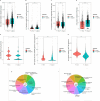Genome plasticity shapes the ecology and evolution of Phocaeicola dorei and Phocaeicola vulgatus
- PMID: 38698002
- PMCID: PMC11066082
- DOI: 10.1038/s41598-024-59148-7
Genome plasticity shapes the ecology and evolution of Phocaeicola dorei and Phocaeicola vulgatus
Abstract
Phocaeicola dorei and Phocaeicola vulgatus are very common and abundant members of the human gut microbiome and play an important role in the infant gut microbiome. These species are closely related and often confused for one another; yet, their genome comparison, interspecific diversity, and evolutionary relationships have not been studied in detail so far. Here, we perform phylogenetic analysis and comparative genomic analyses of these two Phocaeicola species. We report that P. dorei has a larger genome yet a smaller pan-genome than P. vulgatus. We found that this is likely because P. vulgatus is more plastic than P. dorei, with a larger repertoire of genetic mobile elements and fewer anti-phage defense systems. We also found that P. dorei directly descends from a clade of P. vulgatus¸ and experienced genome expansion through genetic drift and horizontal gene transfer. Overall, P. dorei and P. vulgatus have very different functional and carbohydrate utilisation profiles, hinting at different ecological strategies, yet they present similar antimicrobial resistance profiles.
Keywords: Comparative genomics; Gut microbiome; Horizontal gene transfer; Pangenome; Phocaeicola.
© 2024. The Author(s).
Conflict of interest statement
The authors declare no competing interests.
Figures






Similar articles
-
A proteolytically activated antimicrobial toxin encoded on a mobile plasmid of Bacteroidales induces a protective response.Nat Commun. 2022 Jul 23;13(1):4258. doi: 10.1038/s41467-022-31925-w. Nat Commun. 2022. PMID: 35871068 Free PMC article.
-
Extensive Mobilome-Driven Genome Diversification in Mouse Gut-Associated Bacteroides vulgatus mpk.Genome Biol Evol. 2016 Apr 25;8(4):1197-207. doi: 10.1093/gbe/evw070. Genome Biol Evol. 2016. PMID: 27071651 Free PMC article.
-
Genomes of Bacteroides ovatus, B. cellulosilyticus, B. uniformis, Phocaeicola vulgatus, and P. dorei isolated from gut cavernous fistulous tract micropathologies in Crohn's disease.Microbiol Resour Announc. 2024 Apr 11;13(4):e0115223. doi: 10.1128/mra.01152-23. Epub 2024 Feb 27. Microbiol Resour Announc. 2024. PMID: 38411071 Free PMC article.
-
First case of an invasive Bacteroides dorei infection detected in a patient with a mycotic aortic aneurysm-raising a rebellion of major indigenous bacteria in humans: a case report and review.BMC Infect Dis. 2021 Jun 30;21(1):625. doi: 10.1186/s12879-021-06345-8. BMC Infect Dis. 2021. PMID: 34193073 Free PMC article. Review.
-
The Ecology and Evolution of Pangenomes.Curr Biol. 2019 Oct 21;29(20):R1094-R1103. doi: 10.1016/j.cub.2019.08.012. Curr Biol. 2019. PMID: 31639358 Review.
Cited by
-
Assessing the safety of microbiome perturbations.Microb Genom. 2025 May;11(5):001405. doi: 10.1099/mgen.0.001405. Microb Genom. 2025. PMID: 40371892 Free PMC article. Review.
-
The association between gut microbiota composition and cardiometabolic parameters in healthy adults.BMC Microbiol. 2025 Aug 14;25(1):505. doi: 10.1186/s12866-025-04261-4. BMC Microbiol. 2025. PMID: 40813961 Free PMC article.
-
Effects of cRG-I Prebiotic Treatment on Gut Microbiota Composition and Metabolic Activity in Dogs In Vitro.Microorganisms. 2025 Aug 5;13(8):1825. doi: 10.3390/microorganisms13081825. Microorganisms. 2025. PMID: 40871329 Free PMC article.
-
Gut microbiota profiles of peninsular Malaysian populations are associated with urbanization and lifestyle.Sci Rep. 2025 Jul 5;15(1):24066. doi: 10.1038/s41598-025-07117-z. Sci Rep. 2025. PMID: 40617918 Free PMC article.
-
The colonic mucosal virome in inflammatory bowel disease reveals Crassvirales depletion and disease-specific virome features.Gut Microbes. 2025 Dec;17(1):2539450. doi: 10.1080/19490976.2025.2539450. Epub 2025 Aug 3. Gut Microbes. 2025. PMID: 40754936 Free PMC article.
References
-
- Castellani A, Chalmers A. Manual of Tropical Medicine. Williams Wood and Co.; 1919.
Publication types
MeSH terms
Grants and funding
LinkOut - more resources
Full Text Sources

